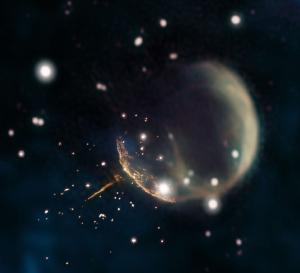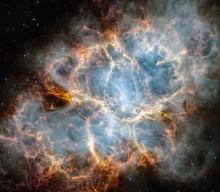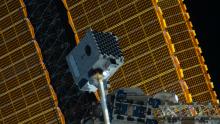A stellar corpse is racing away from its "birthplace" at more than two million miles per hour, leaving a glowing trail in its wake. In this composite image, the star is the bright orange streak at the lower left of the large bubble, which is the expanding residue of an exploding star called a supernova. The star's core was crushed to incredible density, forming a heavy, rapidly rotating object known as a pulsar. The blast gave the object a big "kick," pushing it fast enough to allow it to someday escape the Milky Way Galaxy. Astronomers have nicknamed it the "cannonball pulsar." [Jayanne English (Univ. Manitoba)/F. Schinzel et al.; NRAO/AUI/NSF; DRAO/Canadian Galactic Plane Survey; NASA/IRAS]
You are here
Cannonball Run
A stellar “cannonball” is racing across the constellation Cassiopeia at more than two million miles per hour. And it’s leaving a long trail behind it.
The cannonball is a pulsar — the spinning, superdense corpse of an exploded star. The explosion was a supernova. When the original star’s core could no longer produce energy, it collapsed. That formed a neutron star — an object more massive than the Sun, but only the size of a city. It spins about nine times per second, sending out “pulses” of radio waves.
The explosion that created the neutron star probably was a little off center. That gave the star a big kick, sending it careening away from the site of the explosion.
Astronomers discovered the star in 2019. Using radio and X-ray telescopes, they’ve since found a trail behind it that’s trillions of miles long. It has some bends and kinks, suggesting that the star is passing through thick clouds of gas.
Astronomers also found a “bow shock” in front of the star — gas and dust that’s being “squeezed” by the speedy cannonball, like water ahead of a fast boat. The star should be moving fast enough to escape the galaxy — and blast through the gulf between galaxies on its own.
Cassiopeia the queen is high in the northeast at nightfall. It looks like a sideways letter W. The cannonball star is near the top right point of the W. But it’s much too faint to see without the right kind of telescope.
Script by Damond Benningfield
Get Premium Audio
Listen to today's episode of StarDate on the web the same day it airs in high-quality streaming audio without any extra ads or announcements. Choose a $8 one-month pass, or listen every day for a year for just $30.







